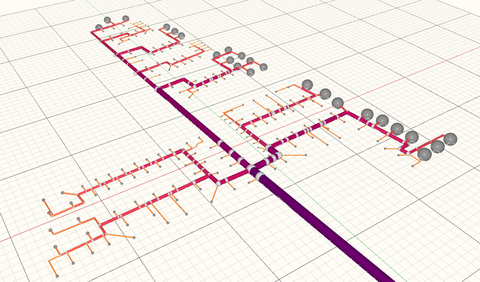Oct 11, 2021
PhD thesis of M.Sc. Hauke Hirsch

Illustration of local heating networks in combination with large-scale geothermal collectors
Development of a modeling tool for the calculation of cold local heating networks in combination with large-scale geothermal collectors.
Backround
Due to the climate policy goals of Germany and numerous other countries worldwide, alternative systems for heat generation are becoming increasingly important. Heat pumps play a key role here. Apart from solar thermal energy, which can generally only cover a small proportion, there is hardly any other way of supplying buildings with climate-neutral heat. It can therefore be assumed that the market share of heat pumps will continue to increase significantly in the future, as it has in the past. As a heat source, the heat pump has various media at its disposal, which differ significantly in terms of their efficiency. While the simple and inexpensive to implement air-water heat pump has a comparatively low efficiency, ground-coupled heat sources are much more efficient, since the ground as a heat source, especially during the heating period, has a higher temperature than the outside air. The disadvantages of these systems are the higher investment costs and land consumption, as well as environmental restrictions on the construction of the systems.
From the point of view that energy concepts are increasingly designed for entire neighborhoods, cold local heating networks in combination with near-surface geothermal collectors are a promising concept. The systematic development of entire building areas with geothermal energy reduces the capital expenditure and uses areas outside the built-up plots as a heat source. Not to be neglected is the cold local heating network as an additional heat source. The pipes are laid without thermal insulation and thus form an integral part of the geothermal heat collector. To keep the area required for the geothermal collector small, it is laid compactly and in several layers. In contrast to deep drilling, this offers the advantage that no permits are required and in some cases environmentally protected areas are available.
Furthermore, cold local heating networks offer the possibility of integrating various waste heat sources, such as server centers or large refrigeration generators in supermarkets. This creates synergies. The required cooling demand can be made available with little effort and the heat source temperature is raised at the same time, which improves the efficiency of the heat pumps. The increasing demand for space cooling in the wake of climate change can also be met efficiently in this way. Since the ground is comparatively cold at the end of the heating period, buildings can be cooled directly, i.e. without the use of chillers.
Problem
Large-scale geothermal collectors are currently implemented in several pilot projects in connection with cold local heating networks. While numerical methods for the calculation of geothermal collectors are already available, the design of the networks is based on simple power or heat quantity based calculation values. Neither the specific soil properties and the local climate of the site, nor the effect of heat input by cooling, industrial waste heat or solar thermal energy are considered with sufficient accuracy. The overall thermal effect of the network thus remains largely unknown and optimization potentials remain untapped.
For a design of the overall system aiming at optimal operation, coupled modeling of the geothermal collector, the local heating network and, if necessary, other heat sinks and sources, such as buildings and heat pumps, is necessary. This requirement arises from the interactions of the various components, which have not been considered in practice to date due to their complexity.
For example, buildings can only be cooled if there is a correspondingly low temperature in the network. Since the heat supplied by cooling in turn affects the grid temperature, this leads to a complete coupling between grid temperature and cooling capacity. The situation is similar with heat pumps. The coefficient of performance and the extraction capacity of the heat pumps increase with the evaporator temperature. If the local heating network has a higher temperature, a higher power is therefore also extracted from it. The higher the temperature, the greater the load on the network. The heat provided by solar thermal collectors also depends to a large extent on the network temperature. The output of solar thermal collectors is limited by the heat loss to the environment. Especially in the case of uncovered (non-glazed) solar thermal collectors, which are particularly interesting for coupling with the ground, these heat losses increase strongly with the fluid temperature.
The amount of heat extracted from the ground also depends significantly on its thermal properties. The heat flow in the soil or from the soil to the fluid in the pipeline is proportional to the thermal conductivity of the soil. If the ground has a higher thermal conductivity, a higher heat flow can be extracted from it for the same temperature difference. If the thermal conductivity of the soil is higher, the geothermal collectors can therefore be dimensioned smaller.
Since the thermal conductivity varies approximately in a range between 1...2 W/mK depending on soil type, bedding density and water content, its exact determination is essential. This in turn requires the determination of the water content, which also affects the freezing behavior of the soil. It is therefore necessary to map both the thermal and hygric behavior of the soil in great detail. For this purpose, reliable thermal and hygric parameters must be determined for the different soil types.
Aims of the work
The development and calibration of a modeling software, which enables the coupled simulation of geothermal collector, local heating network and any other heat sources and sinks, shall contribute to the solution of the described problems. The focus is on a detailed thermal mapping of the technical components, as well as on a hygrothermal mapping of the soil.
The software should make it possible to map the entire plant, including the soil body, at various levels of detail and thus evaluate the influence of the various components, especially the local heating network. Therefore, one focus is on the improvement of the soil parameterization. Based on literature and experimental investigations, a procedure shall be developed which allows the correct selection of the necessary parameters.
By taking into account the additional heat gains of the network, the geothermal collector can be more accurately sized as a heat source. In addition, the influence of other sources such as solar thermal collectors or industrial waste heat can be quantified, which also influences the dimensioning.
 © M. Kretzschmar
© M. Kretzschmar
Research assistant
NameHauke Hirsch M.Sc.
Send encrypted email via the SecureMail portal (for TUD external users only).
